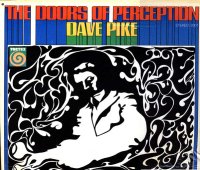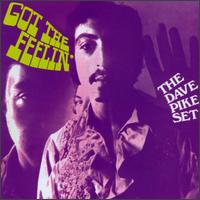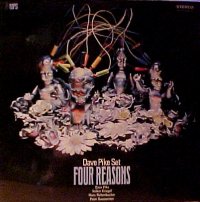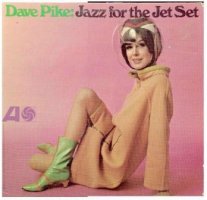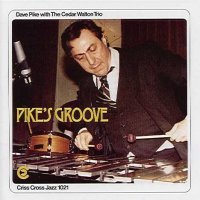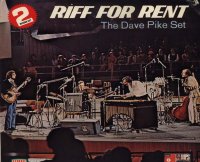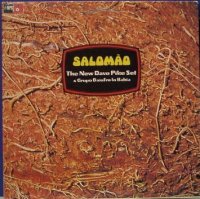  |
|
|
|
|
Dave Pike has been a consistently active percussionist over the past 40-plus years, specializing in vibraphone and marimba, and has built quite an impressive resume to stand on. Yet, because the meat of his career was spent recording for a European label at a time when jazz music was losing steam in mainstream America, he has been among the countless musicians to have taken his place amongst the more obscure and only recently sought after jazz musicians of the mid-Twentieth Century. Naturally, it could be argued that had a label like Blue Note or Verve picked up Pike, his creativity could have been fostered at home while his place in jazz history become more important to the masses. However, Riverside, Prestige, Carnival and Epic couldn't, and we can only work with what did happen. Pike's history reads more or less like this.... Born in Detroit MI in 1938, Pike began playing drums and used that percussive background to learn instruments like the marimba and vibraphone. When his family moved to Los Angeles in 1954 it wasn’t long before Pike established himself as a sideman, playing with the likes of Dexter Gordon, Harold Land, Carl Perkins, Paul Bley and Curtis Counce. After establishing himself in California, Pike felt the pull to a larger jazz market and took up shop in New York in 1960. Once in New York, Pike began building a larger name for himself, mainly by joining Herbie Mann’s group. This served as an important step for different reasons. First, Pike’s experience with Mann drew him further into the Latin Jazz scene. In 1964, Pike recorded his first full Latin jazz album on Decca called "Manhattan Latin". This album has since become a highly sought after album in Latin jazz communities, and some would argue that heavy interest in this album in the late 1980’s directly led to the discovery of a song called "Mathar", recorded in Germany some four years later. That’s getting slightly ahead though.... Pike’s time in New York and services with Herbie Mann also led to a recording contract with Atlantic Records, for whom Pike would record two albums. A 1965 session featuring the unusual talents of Herbie Hancock (still firmly on Blue Note), Billy Butler (who was at the time a new member of the Prestige roster) and other big names such as Clark Terry and Grady Tate, became Pike’s first album on Atlantic, "Jazz for the Jet Set" (Atlantic 1457). Pike played marimba exclusively on this album, while Hancock played Hammond, rather than his usual piano. The commercial highlight of "Jazz for the Jet Set" was certainly a bright reading of Hancock’s "Blind Man, Blind Man" which starts off the album. Somewhat uneven throughout, "Jazz for the Jet Set" also does manage bright moments in "Sweet Tater Pie", "Jet Set" and "When I’m Gone". Another shrewd commercial move was the cover art, featuring an attractive model adorned in the 1966 Pan-Am stewardess uniform (complete with space helmet!), designed by the elite Italian fashion mogul, Emilio Pucci. Regrettably, such a fashionable addition to the album didn’t seem to have aided its sales figures. This album marks the move from Pike’s earlier straight ahead style to what became his most imaginative period delving into soul music - which Atlantic Records was a key player at the time - more commercial pop arrangements, as well as taking a step "outside", seemingly searching out a more experimental style. These influences were more matured for a 1966 recording session which became the album "The Doors of Perception", notably with Lee Konitz on saxophone. "The Doors of Perception" was released by the Atlantic subsidiary Vortex, but not until 1970. One cut in particular from this album, "The Drifter", foreshadowed Pike’s next few years, which were spent in Germany. Also worth noting is a tape of live material recorded at the Village Gate in New York on September 28, 1966 which has apparently been floating around circles of Lee Konitz fans and features a handful of tracks that appeared on "The Doors of Perception". The line up is, Dave Pike (vibes), Lee Konitz (as), Eddie Daniels (ts,cl), Don Friedman (p), Chuck Israel (b,el-b), Arnie Wise (dr). One can speculate that Atlantic’s initial shelving of "The Doors of Perception" hastened Pike’s decision to leave New York for Germany, though it can’t be denied that Europe offered musicians far greater artistic freedom than the majority of American recording houses. By this time, most major labels were becoming more and more aware of the financial bottom line and wielding a heavy hand on both their recording roster and their marketable outlets such as radio and television. By the late 1960’s, MPS was well established as the German jazz label of choice. Already having secured the services of Oscar Peterson and Jean-Luc Ponty, Pike joined the MPS label in 1968 and teamed up with a visionary guitarist named Volker Kriegel. Kriegel is the likely introduction of Indian ragas to Pike’s repertoire. This influence showed up immediately on "Four Reasons", Pike’s first album for MPS. The album’s opening track is a a blazing jazz raga number penned by Kriegel, "Greater Kalesh No. 48". This album features a solid line up of Pike on vibes, Kriegel on guitar, sitar and electric bass, J.A. Rettenbacher on bass, cello and electric bass, and Peter Baumeister on drums. Collectively known as The Dave Pike Set, this lineup would record at least another three albums together. The Set’s next album for MPS, "Noisy Silence - Gentle Noise", released in 1969 (MPS 15215), was a further exploration into funky jazz with brilliant guitar work and Indian influences, the stand out track being one called "Mathar", which more attention will be given to in just a bit However, the entire album is a treat. The Dave Pike Set was now well established in European jazz circles and was becoming quite popular, though this popularity still didn’t seem to make much of a ripple in America. To capitalize on this popularity, "Live at the Philharmonie" (MPS 20705) was released. While not their most outstanding album, it is a well recorded document of the group’s ability to take their studio magic out on stage with them, with the sitar being notably absent. Quickly after the live recording, a studio followup was released, titled "Infra-Red". A remarkably solid album, "Infra-Red" features a number of amazing Indian-fused numbers, not the least of which being "Raga Jeeva Swara" and "Soul Eggs". All four members of the set contributed songs to the album, which is a tad unusual, as Peter Baumeister was not nearly as proficient as the other three at writing in preceding outings, but did emphasize the Set as a unified group rather than a series of recording sessions with Pike at the helm. 1971 didn’t seem to slow Pike down, but information on recordings of this year has been difficult to come by. I’ve found references to three MPS catalogue numbers from this year (10.21688-8, 21.20881 and 21.21541) but I’ve only been able to verify one, titled "Album" which can be found as a Japanese CD reissue. "Album" features tracks such as "Big Schlepp", and "Country Shit", and is representative of Pike's other MPS works, but aside from some great guitar work from Volker Kriegel, is more of a proper jazz album than the funk jazz styles the Set had recorded on earlier efforts. In 1972 MPS repackaged "Four Reasons" and "Live at the Philharmonie" together as "Riff For Rent" (MPS 25112). Essentially, was the end of the MPS era for Dave Pike, but he would bow out after one more album, as the New Dave Pike Set. "Salomao" was released in 1973 with the "New" Dave Pike Set, featuring Volker Kriegel on guitar, Eberhard Weber on bass and Marc Hellman on drums. "Salomao" was recorded in Brazil in 1972 with a group of Brazilian percussionists called Grupo Baiafro. Volker Kriegel was still lending his prolific pen to the majority of the songwriting, but the album heavily explored progressive Brazilian rhythms with quite an experimental edge. While fairly mellow in general, the experimental nature of this album does not make it among Pike's easiest to listen to. By the mid-1970’s Pike found himself back in America and recorded four albums for Muse through 1981, none of which were very successful. Still active though, Pike recorded two more albums in the 1980’s before seemingly dropping out of active recording. Of course, by this time the acid jazz craze was beginning to rear its head and along with it, a whole new community of record collectors and DJ’s actively searching out "rare grooves" and new club hits. While the "Manhattan Latin" album was picking up steam again in Latin circles, the funk jazz crowds were just about to find their hidden gem, presumably due to the efforts of English DJ Giles Peterson, who was behind the Talking Jazz compilations. "Mathar" became (and remains) a huge club hit, and was recorded by Paul Weller under the guise of Indian Vibes for a now insanely rare French single on Yellow Productions (YP001M) in 1994. The Weller single was reissued in the UK on Virgin as a 12", and Pike’s original was released as a 12" (complete with techno remixes, no less) on Outcaste (Out9x) and on a Tommy Boy 12" EP with Ananda Shankar’s "Streets of Calcutta" in 1997. "Mathar" also appears on The Mojo Club’s Dancefloor Jazz Vol. 3, and UK label Talkin Loud’s "Talkin Jazz Vol 2". Clearly, this song’s rediscovery in the late 1980’s, and it’s subsequent fervor among rare groove and funk jazz fans has been instrumental in revitalizing Pike’s career. Still, the majority of the aforementioned reissues aren’t readily available to the masses. Dave Pike's introduction to a new, younger and more ravenous audience which has recently lifted Pike to his newly found cult status - at least on a larger scale - was the 1998 issue of the "Got the Feelin" album, which was released on Wagram Records. Wagram Records is the independent work of Phil Lehman, one of the co-owners of Desco Records, the premier new funk label in America. The reissue of this album has insured the continued interest in Dave Pike’s work, particularly in America, where Pike’s material has been even more difficult to locate than in Europe. "Got the Feelin" was recorded in Holland, 1968, for release on a rock label, Relax Records (also housed Dutch beat legends, The Outsiders), with Rob Franken on organ, Joop Schotten on guitar, Ruud Jacobs on electric bass and Louis de By behind the drums. Joop Schotten contributed five original compositions to the album, while Pike co-wrote the album's best tracks, "Bacon Fat" and "Middle Earth Herd", with Raoul Dohmen. Additionally, this version of the Dave Pike Set recorded covers of Sam & Dave's "You Got It Made", Burt Bacharach's "Do You Know the Way To San Jose", The Classics IV's "Spooky" and the title track, James Brown's "Got the Feelin". Simultaneously, the Ubiquity label in San Francisco made contact with Pike, now living in Los Angeles, and in 1998 released an albums worth of all new material called "Bop Head", which find’s Pike working out fluidly in a straight-ahead style. Under Ubiquity’s wing, Pike also recorded with Johnny Blas, a brilliant young Afro-Cuban traditionalist, on Blas’s "Skin & Bones" album, released on Ubiquity’s sister label, Cubop. Ubiquity also has Pike recording another album, this time teamed up with another Latin giant, Bobby Matos. "Peligroso" is set for an August 2000 release with the promise of Pike’s first Latin jazz album since "Manhattan Latin", according to Ubiquity’s publicity on Pike. Obviously, Pike’s time with Herbie Mann had a deeper affect on him than at first glance and luckily for today’s jazz fans, Pike shows no signs of letting up now. It certainly is something worth looking forward to from this long under-rated percussionist. *Thanks to Andrew Jervis at Ubiquity, and the All Music Guide for pieces of information found in this article. Teach me more about the 60's vibes sound >>>> Send Me Back To The Cover Daddio..... |
